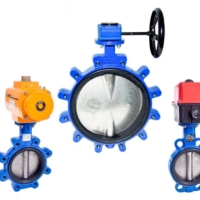In the case of a Wafer-style butterfly valve, the body is annular with a few non-tapped centring holes. Some Wafer types have two while others have four.
The flange bolts are inserted through the bolt holes of the two pipe flanges and the centering holes of the butterfly valve. By tightening the flange bolts, the pipe flanges are pulled towards each other and the butterfly valve is clamped between the flanges and held in place.
In the case of a Lug-style butterfly valve there are so-called “ears” over the entire circumference of the body into which threads were tapped. In this way, the butterfly valve can be tightened against each of the two pipe flanges by means of 2 separate bolts (one on each side).
Because the butterfly valve is attached to each flange on both sides with separate, shorter bolts, the chance of relaxation through thermal expansion is smaller than with a Wafer-style valve. As a result, the Lug version is more suitable for applications with large temperature differences.
*However, when the Lug-style vavle is used as the end valve, one should pay attention because most Lug-style butterfly valves will have a lower maximum allowed pressure as the end valve than their “normal” pressure class indicates.

